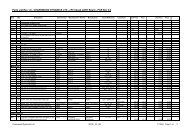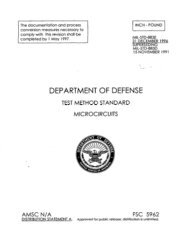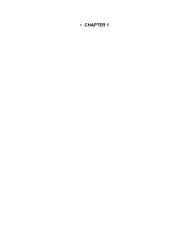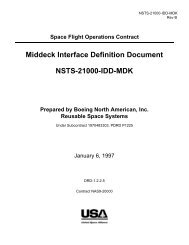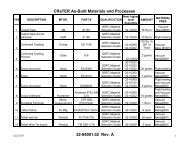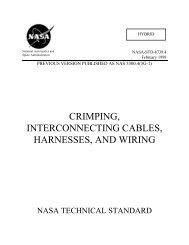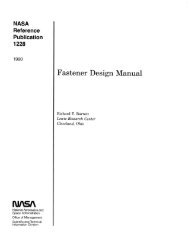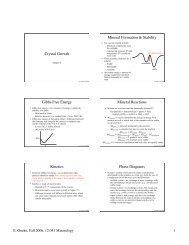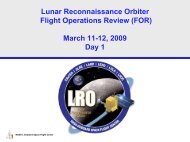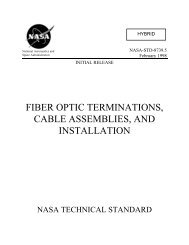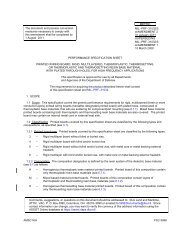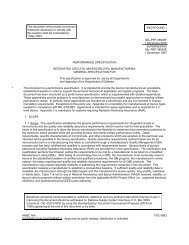Criteria for Preloaded Bolts
Criteria for Preloaded Bolts
Criteria for Preloaded Bolts
Create successful ePaper yourself
Turn your PDF publications into a flip-book with our unique Google optimized e-Paper software.
National Aeronautics and<br />
Space Administration<br />
Lyndon B. Johnson Space Center<br />
Houston, Texas 77058<br />
SPACE SHUTTLE<br />
CRITERIA FOR PRELOADED BOLTS<br />
NSTS 08307<br />
REVISION A<br />
JULY 6, 1998<br />
REPLACES<br />
NSTS 08307<br />
BASELINE
CONTENTS<br />
NSTS 08307<br />
1.0 INTRODUCTION . . . . . . . . . . . . . . . . . . . . . . . . . . . . . . . . . . . . . . . . . . . . . . 1-1<br />
1.1 PURPOSE . . . . . . . . . . . . . . . . . . . . . . . . . . . . . . . . . . . . . . . . . . . . . . . . . . . . 1-1<br />
1.2 SCOPE . . . . . . . . . . . . . . . . . . . . . . . . . . . . . . . . . . . . . . . . . . . . . . . . . . . . . . . 1-1<br />
2.0 APPLICABLE DOCUMENTS . . . . . . . . . . . . . . . . . . . . . . . . . . . . . . . . . . . . 2-1<br />
3.0 REQUIRED CRITERIA FOR PRELOADED BOLTS . . . . . . . . . . . . . . . . 3-1<br />
3.1 INTRODUCTION . . . . . . . . . . . . . . . . . . . . . . . . . . . . . . . . . . . . . . . . . . . . . . 3-1<br />
3.2 DEFINITIONS . . . . . . . . . . . . . . . . . . . . . . . . . . . . . . . . . . . . . . . . . . . . . . . . . 3-1<br />
NSTS 08307<br />
Revision A<br />
3.2.1 Definition of Terms . . . . . . . . . . . . . . . . . . . . . . . . . . . . . . . . . . . . . . . . . . . . 3-1<br />
3.2.2 Definition of Symbols . . . . . . . . . . . . . . . . . . . . . . . . . . . . . . . . . . . . . . . . . 3-2<br />
3.2.3 Definition of Application Specific Testing . . . . . . . . . . . . . . . . . . . . . . . . . 3-3<br />
3.3 CALCULATION OF THE MAXIMUM AND MINIMUM PRELOADS . . . 3-5<br />
3.4 TYPICAL PRELOAD UNCERTAINTIES . . . . . . . . . . . . . . . . . . . . . . . . . . 3-6<br />
3.5 TYPICAL COEFFICIENTS OF FRICTION/NUT FACTOR . . . . . . . . . . . 3-7<br />
3.6 EXPECTED PRELOAD LOSS . . . . . . . . . . . . . . . . . . . . . . . . . . . . . . . . . . . 3-8<br />
3.7 PRELOADED BOLT STRENGTH CRITERIA . . . . . . . . . . . . . . . . . . . . . . 3-8<br />
3.8 PLASTIC BENDING . . . . . . . . . . . . . . . . . . . . . . . . . . . . . . . . . . . . . . . . . . . 3-10<br />
3.9 PRELOADED BOLT SEPARATION CRITERIA . . . . . . . . . . . . . . . . . . . . 3-11<br />
3.10 PRELOADED BOLT FATIGUE AND FRACTURE CRITERIA . . . . . . . . 3-12<br />
3.11 RE-TORQUING OF PRELOADED BOLTS . . . . . . . . . . . . . . . . . . . . . . . . 3-12<br />
v<br />
CHANGE NO. 3
1.0 INTRODUCTION<br />
1.1 PURPOSE<br />
The methodology and criteria defined in this document shall be applicable when it is<br />
determined that a bolted joint requires preloading to successfully per<strong>for</strong>m its function.<br />
Generally, bolts that experience increased axial tensile loads as a result of the applied<br />
external load will require preloading to reduce cyclic stresses, prevent pressure<br />
leakage, prevent joint separation, or increase system stiffness. This methodology and<br />
criteria provides a set of minimum requirements which are adequate, but not overly conservative,<br />
so that the design and analysis of preloaded joints are addressed in a<br />
consistent and acceptable manner throughout the Space Shuttle Program.<br />
1.2 SCOPE<br />
This document presents a basic, required set of methodology and criteria that each preloaded<br />
joint must meet. Also presented are suggested criteria and/or procedures that<br />
should be understood and considered in the design and analysis of preloaded joints.<br />
NSTS 08307<br />
Revision A<br />
1-1 CHANGE NO. 3
2.0 APPLICABLE DOCUMENTS<br />
The following documents of the date and issue shown <strong>for</strong>m a part of this document to<br />
the extent specified herein.<br />
NSTS 08307<br />
Revision A<br />
FED-STD-H28 Screw Thread Standards <strong>for</strong> Federal Services<br />
Ref. Apx. A<br />
2-1 CHANGE NO. 3
3.0 REQUIRED CRITERIA FOR PRELOADED BOLTS<br />
3.1 INTRODUCTION<br />
A preloaded joint must meet (as a minimum) the following three basic requirements:<br />
a. The bolt must have adequate strength (reference Paragraph 3.7).<br />
b. The joint must demonstrate a separation factor of safety at limit load. This usually<br />
requires that no joint separation occur (reference Paragraph 3.9).<br />
c. The bolt must have adequate fracture and fatigue life (reference Paragraph<br />
3.10).<br />
Bolt strength is checked at maximum external load and maximum preload, and joint<br />
separation is checked at maximum external load and minimum preload. To do this, a<br />
conservative estimate of the maximum and minimum preloads must be made, so that<br />
no factors of safety are required <strong>for</strong> these preloads. Safety factors need only be applied<br />
to external loads. The criteria specifies how these preloads are to be determined.<br />
3.2 DEFINITIONS<br />
The following are definitions of terms used in the preloaded bolt criteria:<br />
3.2.1 Definition of Terms<br />
a. Limit Load. Limit load is the maximum expected external load a joint will experience<br />
during service. Limit load does not include the preload and the positive<br />
and negative thermal loads (as defined in this section).<br />
b. Axial Load. An axial load is a load (or component of a load) that is parallel to<br />
the bolt’s longitudinal axis. An axial load may be either tensile or compressive.<br />
c. Yield Load. Yield load is limit load multiplied by the yield factor of safety.<br />
d. Ultimate Load. Ultimate load is limit load multiplied by the ultimate factor of<br />
safety.<br />
e. Joint Separation Load (P sep). Joint separation load is the limit load multiplied<br />
by the joint separation factor of safety. The joint separation load must always<br />
be greater than or equal to limit load.<br />
f. Maximum Preload (PLD max). The maximum preload is a reasonable estimate<br />
of the maximum expected preload in a bolted joint at operating conditions. The<br />
maximum preload must be calculated using one of the procedures presented in<br />
Paragraph 3.3.<br />
NSTS 08307<br />
Revision A<br />
3-1 CHANGE NO. 3
g. Minimum Preload (PLD min). The minimum preload is a reasonable estimate of<br />
the minimum expected preload in a bolted joint at operating conditions. The<br />
minimum preload must be calculated using one of the procedures presented in<br />
Paragraph 3.3.<br />
h. Expected Preload Loss (P loss). The expected preload loss is an estimate of the<br />
decrease in the preload of a bolted joint due to permanent set during service.<br />
The preload loss term must meet the requirements of Paragraph 3.6.<br />
i. Prevailing Torque (T p). The prevailing torque is a torque that is independent of<br />
the preload level, and is due to some feature such as a self-locking nut.<br />
j. Positive/Negative Thermal Load. The positive thermal load (P thr pos ) is the thermally<br />
induced load that increases the preload, and the negative thermal load<br />
(P thr neg ) is the thermally induced load that decreases the preload. These two<br />
thermal loads refer only to the axial load caused by a difference in the coefficients<br />
of thermal expansion of the bolt and joint, and/or a difference in the<br />
temperature between the bolt and joint.<br />
k. Initial Torque-Yield. Initial torque-yield is the initial yield of a bolted joint in<br />
which the bolt is in the process of being torqued. Initial torque-yield is usually<br />
due, in part, to the torquing process.<br />
3.2.2 Definition of Symbols<br />
a. External/Internal Loads:<br />
NSTS 08307<br />
Revision A<br />
P = External axial load applied to joint at bolt location due to application<br />
of limit load to the structure<br />
P b = Bolt axial load resulting from yield, ultimate or joint separation load<br />
V = Bolt shear load resulting from limit load<br />
M = Bolt bending moment resulting from limit load<br />
b. Factors of Safety:<br />
SF = Bolt strength factor of safety<br />
SF sep = Joint separation factor of safety<br />
c. Allowables/Strengths:<br />
PA t = Axial load allowable of bolt due to tension<br />
PA s = Axial load allowable of bolt or nut due to thread shear<br />
3-2 CHANGE NO. 3
NSTS 08307<br />
Revision A<br />
VA = Shear load allowable of bolt<br />
MA = Bending load allowable of bolt<br />
d. Geometric Properties/Constants:<br />
D = Basic major diameter of external threads (bolt)<br />
E = Basic pitch diameter of external threads (bolt)<br />
K b = Stiffness of bolt<br />
K j = Stiffness of joint<br />
n = Loading-plane factor (see Figure 3-1)<br />
n o = Threads/inch<br />
R o = Outer radius of torqued element (nut or head)<br />
R i = Inner radius of torqued element (nut or head)<br />
R t = Effective radius of thread <strong>for</strong>ces<br />
= 1/2 x E . . . approximately<br />
R e = Effective radius of torqued element-to-joint bearing <strong>for</strong>ces<br />
= 1/2 x (R o + R i)<br />
= Thread lead angle<br />
= Tan -1 [1/(n oE) ] . . . <strong>for</strong> unified thread <strong>for</strong>m<br />
= Thread half angle<br />
= 30° . . . <strong>for</strong> unified thread <strong>for</strong>m<br />
= Load factor<br />
= K b/(K b + K j)<br />
= 3.1415927<br />
NOTE: n and can be determined by analysis or tests.<br />
3.2.3 Definition of Application Specific Testing<br />
Application specific testing refers to test conditions that closely resemble the actual configuration.<br />
Minimally, an application specific test must include the following items:<br />
a. Torque-Preload Tests:<br />
1. Same lubricants<br />
3-3 CHANGE NO. 3
NSTS 08307<br />
Revision A<br />
2. Same thread <strong>for</strong>m<br />
3. Same bolt diameter<br />
4. Same type/size of torqued element (nut or bolt head)<br />
5. Same joint configuration<br />
(a) Thickness<br />
(b) Material(s)<br />
(c) Surface finish<br />
(d) Washer(s)<br />
(e) Nut/nutplate/insert<br />
6. Same torque method<br />
(a) Approximately the same type of torque wrench<br />
(b) Torqued from same element (bolt head or nut)<br />
b. Preload Loss Tests:<br />
1. Same preload level<br />
2. Same length of thread engagement<br />
3. Same bolt head and nut type/size/material<br />
4. Same bolt diameter<br />
5. Same joint configuration<br />
(a) Material(s)<br />
(b) Surface finish<br />
(c) Washer(s)<br />
(d) Number of joint interfaces<br />
6. Same angle between bolt head/nut and joint interface<br />
A valid application specific test must include an adequate sample and an acceptable<br />
statistical analysis. The application specific test and data reduction are subject to<br />
review and approval by the appropriate NASA center. In addition, other test results<br />
3-4 CHANGE NO. 3
and/or an experience base, which does not adhere to the strict definition of application<br />
specific testing, may be substituted <strong>for</strong> this application specific testing if approved by the<br />
appropriate NASA center.<br />
3.3 CALCULATION OF THE MAXIMUM AND MINIMUM PRELOADS<br />
The bolt strength criteria, the bolt fatigue and fracture criteria, and the joint separation<br />
criteria do not require that the preload be multiplied by yield, ultimate or joint separation<br />
factors of safety, yet any uncertainty in the preload must be taken into account. This is<br />
done by defining a maximum preload (PLD max) and a minimum preload (PLD min).<br />
The maximum and minimum preloads must be calculated using one of the following<br />
three procedures (Procedure A, Procedure B or Procedure C). The procedure chosen<br />
must be appropriate <strong>for</strong> the specific application.<br />
a. Procedure A. If the preload is achieved by measuring the applied torque<br />
without torquing to initial torque-yield, the maximum and minimum preloads<br />
must be calculated using one of the following two methods (Typical Coefficient<br />
Method or Experimental Coefficient Method).<br />
NSTS 08307<br />
Revision A<br />
1. Typical Coefficient Method. The following four items must be included in<br />
the calculation of the maximum and minimum preloads:<br />
(a) The maximum and minimum torques of the specified torque-range<br />
plus any prevailing torque (T max, T min and T p).<br />
(b) The uncertainty () <strong>for</strong> torque measurement as listed in Paragraph<br />
3.4.<br />
(c) The typical coefficient of friction at the external-to-internal thread interface<br />
( t typ ) and the nut-to-joint bearing interface (b typ ) OR the typical<br />
nut factor (K typ ). The typical coefficients of friction and the typical nut<br />
factor must meet the requirements of Paragraph 3.5.<br />
(d) The positive and negative thermal loads (P thr pos and Pthr neg ).<br />
The maximum and minimum preloads must be calculated using the following<br />
equations:<br />
PLD max = (1 + )T max/[R t (tan + t typ /cos) + Re b typ ] + Pthr pos<br />
PLD min = (1 - ) (T min - T p)/[R t (tan + t typ /cos) + Re b typ ] + Pthr neg - Ploss<br />
OR<br />
PLD max = (1 + )T max/K typ D + P thr pos<br />
PLD min = (1 - ) (T min - T p)/K typ D + P thr neg - Ploss<br />
3-5 CHANGE NO. 3
NSTS 08307<br />
Revision A<br />
2. Experimental Coefficient Method. The use of the uncertainty factor can be<br />
avoided if application specific testing is done to determine t, b and K.<br />
Here both the maximum and minimum values of these coefficients must<br />
be determined. The maximum and minimum preloads are calculated as<br />
follows:<br />
PLD max =T max/[R t (tan + t min /cos) + Re b min ] + Pthr pos<br />
PLD min =T min - T p)/[R t (tan + t max /cos) + Re b max ] + Pthr neg - Ploss<br />
PLD max =T max/K min D + P thr pos<br />
OR<br />
PLD min =(T min - T p)/K max D + P thr neg - Ploss<br />
b. Procedure B. If the preload is achieved by torquing the bolt to initial torqueyield,<br />
the maximum and minimum preloads must be determined from an<br />
application specific test. The torque wrench must be designed to detect initial<br />
torque-yield of the bolt and the test wrench must have the same accuracy as<br />
the wrench used on the actual hardware.<br />
c. Procedure C. If the preload is achieved by any means other than torque measurement<br />
or torquing to initial torque-yield, the following four items must be<br />
included in the calculation of the maximum and minimum preloads:<br />
1. The maximum and minimum values of any specified tolerance band placed<br />
upon the preload. (PLD+TOL)<br />
2. The appropriate uncertainty () in the measurement system as listed in<br />
Paragraph 3.4.<br />
3. The positive and negative thermal loads (P thr pos and Pthr neg ).<br />
4. The expected preload loss (P loss).<br />
The maximum and minimum preloads must be calculated using the following<br />
equation:<br />
PLD max = (1 + ) (PLD + TOL) + P thr pos<br />
PLD min = (1 - ) (PLD - TOL) + P thr neg - Ploss<br />
3.4 TYPICAL PRELOAD UNCERTAINTIES<br />
If the Typical Coefficient Method is used to determine the maximum and/or the minimum<br />
preload, the following preload uncertainties () can be used. Other values may be used<br />
3-6 CHANGE NO. 3
when substantiated by an application specific test. If, <strong>for</strong> example, a particular lubricant<br />
demonstrates a typical uncertainty of ±35% in an application specific torque-preload<br />
test, the uncertainty that must be used is ±35%. The uncertainty and the application<br />
specific test are subject to review and approval by the appropriate NASA center.<br />
These uncertainties shall be used <strong>for</strong> small fasteners. Application specific testing is<br />
required <strong>for</strong> large fasteners. In general, a fastener is considered large if it has a<br />
diameter > 3/4”. This determination, however, shall be made with the approval of the<br />
appropriate NASA center.<br />
a. Torque-measurement:<br />
NSTS 08307<br />
Revision A<br />
1. Torque-measurement of unlubricated bolts = ±35%<br />
2. Torque-measurement of cad-plated bolts = ±30%<br />
3. Torque-measurement of lubricated bolts = ±25%<br />
b. Other methods:<br />
1. Hydraulic tensioners = ±15%<br />
2. Preload indicating washers = ±10%<br />
3. Ultrasonic measurement devices = ±10%<br />
4. Bolt elongation measurement = ±5%<br />
5. Instrumented bolts = ±5%<br />
NOTE: If the bolt is torqued from the head, application specific testing to determine<br />
the preload is strongly recommended. Typical uncertainty may<br />
also be determined this way. If experience and/or test data justifies it,<br />
however, an additional uncertainty may simply be added to the above<br />
typical preload uncertainties. This method must be justified to, and<br />
approved by, the appropriate NASA center.<br />
If the preload is determined by a method not listed above, an uncertainty typical of that<br />
device must be used. The uncertainty must include not only the actual stated uncertainty<br />
of the device, but also a typical uncertainty which results from such things as<br />
operator error, unexpected variations in geometry, etc.<br />
3.5 TYPICAL COEFFICIENTS OF FRICTION/NUT FACTOR<br />
The typical coefficients of friction must be typical of the type of bolt-to-joint interfaces<br />
used in the specific application. The parameters that must be considered in selecting a<br />
typical coefficient of friction are the following:<br />
3-7 CHANGE NO. 3
a. Material at the bolt-to-joint interfaces.<br />
b. Surface finish at the bolt-to-joint interfaces.<br />
c. Lubricants at the bolt-to-joint interfaces.<br />
The typical nut factor must be typical of the type of bolt-to-joint interfaces used in the<br />
specific application. In addition, the nut factor must also be typical of the type and size<br />
of nut (or bolt head) used in the specific application. The parameters that must be considered<br />
in selecting a typical nut factor are the following:<br />
a. Material at the bolt-to-joint interfaces.<br />
b. Surface finish at the bolt-to-joint interfaces.<br />
c. Lubricants at the bolt-to-joint interfaces.<br />
d. Nut (or bolt head) type and size.<br />
3.6 EXPECTED PRELOAD LOSS<br />
Most preloaded joints experience some amount of preload loss, due to plastic de<strong>for</strong>mation<br />
(permanent set) and/or vibration. This criteria does not address preload loss due to<br />
vibration, as some method of preventing the nut and/or bolt from vibrating loose should<br />
be part of the basic design of the joint.<br />
Preload loss can vary between about 2% and 10% of the actual preload level in the bolt.<br />
This section does not require that the preload loss be calculated by a particular method.<br />
However, preload loss must be considered in the analysis of preloaded joints and, if a<br />
joint is configured such that its stiffness is primarily dependent upon nonmetallic materials,<br />
or if it does not have metal-to-metal contact throughout, the preload loss must be<br />
determined from an application specific test.<br />
An acceptable method of calculating the preload loss in joints that have metal-to-metal<br />
contact throughout their thickness is the following:<br />
P loss = 5% of the maximum preload<br />
= .05 x PLD max<br />
3.7 PRELOADED BOLT STRENGTH CRITERIA<br />
This section addresses both yield load analysis and ultimate load analysis. Yield factors<br />
of safety and allowables are used during a yield load analysis, and ultimate factors<br />
of safety and allowables are used during an ultimate load analysis. The bolt shall not<br />
yield in the minimum cross-section at yield load and shall not fail at ultimate load.<br />
NSTS 08307<br />
Revision A<br />
3-8 CHANGE NO. 3
Localized yielding of the threads is allowed at yield load if this de<strong>for</strong>mation is not detrimental<br />
to the system.<br />
The load equations presented in this section are based on simple linear preloaded joint<br />
theory. A more accurate, detailed analysis (linear or nonlinear) may be used instead of<br />
the simple linear equations to determine an axial bolt load (P b), a shear bolt load (V),<br />
and/or a bending bolt load (M). The analysis, however, must include the maximum preload<br />
(PLD max) and apply factors of safety to limit load only. The analysis is subject to<br />
review and approval by the appropriate NASA center.<br />
The strength section of the criteria is divided into four categories that reflect the types of<br />
load a preloaded bolt can experience. The four categories are: (1) axial load, (2) shear<br />
load, (3) bending load, and (4) combined axial, shear and/or bending load. Regardless<br />
of the type of analysis, the bolt must meet the criteria presented in each applicable<br />
category.<br />
The strength criteria must also include a condition of no detrimental yielding during<br />
installation of a bolt. This must include the effects of the axial load due to the preload in<br />
combination with the shear due to the torquing. The bolt, bolt threads and the nut must<br />
be checked.<br />
The axial bolt load is calculated using the following equation: (unless a more accurate,<br />
detailed analysis is per<strong>for</strong>med)<br />
P b = PLD max + n (SF x P)<br />
NOTE: The stiffness parameter () and the loading-plane factor (n) may be determined<br />
either by analysis or an application specific test.<br />
a. Axial Load. The axial load allowables (PA t and PA s) must be known quantities<br />
and are usually given by the manufacturers or can be looked up. A suggested<br />
method of calculating them <strong>for</strong> UNF bolts is given in Appendix A.<br />
NSTS 08307<br />
Revision A<br />
1. Minimum Cross-Section of Bolt. The bolt must satisfy the following two<br />
criteria:<br />
Criterion 1: MS = PA t/(SF x P) - 1 ≥ 0<br />
Criterion 2: MS = PA t/P b - 1 ≥ 0<br />
2. Shear Pull-Out of Threads. If an internal thread (nut, nutplate, tapped hole,<br />
etc.) is used that is not guaranteed to develop the full ultimate load capability<br />
of the bolt, or if the internal thread is not fully threaded onto the bolt,<br />
the following two criteria must be met:<br />
3-9 CHANGE NO. 3
NSTS 08307<br />
Revision A<br />
Criterion 1: MS = PA s/(SF x P) - 1 ≥ 0<br />
Criterion 2: MS = PA s/P b - 1 ≥ 0<br />
NOTE: These two criteria need only be checked at ultimate load.<br />
b. Shear Load:<br />
MS = VA/(SF x V) - 1 ≥ 0<br />
c. Bending Load:<br />
MS = MA/(SF x M) - 1 ≥ 0<br />
d. Combined Axial, Shear and/or Bending Load:<br />
If the bolt is subject to a combination of loads, the following relationship must<br />
hold true <strong>for</strong> both maximum and minimum preload.<br />
(R a + R b/K) 2 + R s 3 ≤ 1<br />
1 ≤ K ≤ K y<br />
Where<br />
K y = 1.0 <strong>for</strong> minimum preload<br />
K y = A plastic bending factor based on actual material stress-strain curves<br />
and calculated such that permanent strains do not exceed 0.2% <strong>for</strong><br />
maximum preload<br />
R a = Ratio of axial load to axial load allowable and is chosen as the maximum of<br />
(SF x P)/PA t ; P b/PA t ; PLD max/PA t<br />
R b = Ratio of bending load to bending load allowable,<br />
= (SF x M)/MA<br />
R s = Ratio of shear load to shear load allowable,<br />
= (SF x V)/VA<br />
NOTE: The axial and shear load allowables (PA t and VA) in this interaction<br />
equation are based on the cross-section at which the combined loads<br />
occur.<br />
3.8 PLASTIC BENDING<br />
If the criteria of Paragraph 3.7c or 3.7d cannot be met, but the resulting permanent<br />
de<strong>for</strong>mation will be acceptable, it will be permissible to use a plastic bending theory to<br />
3-10 CHANGE NO. 3
determine the margins of safety. For a sufficiently ductile material, the following criteria<br />
may be used:<br />
a. Bending Load:<br />
NSTS 08307<br />
Revision A<br />
MS = (MA x K p)/(SF x M) - 1 ≥ 0<br />
Where K p is a plastic bending factor<br />
b. Combined Axial, Shear and/or Bending Load:<br />
If the bolt is subject to a combination of loads, the following relationship must<br />
hold true:<br />
R a 2 + Rb + R s 3 ≤ 1<br />
Where R a and R s are the same as be<strong>for</strong>e and<br />
R b = (SF x M)/(MA x K p)<br />
A more exact plastic analysis can be done by using the actual material stress-strain<br />
curve. For a material with limited ductility this must be done if plastic bending is to be<br />
used.<br />
3.9 PRELOADED BOLT SEPARATION CRITERIA<br />
Separation of a preloaded joint must not occur below the joint separation load. The<br />
equations presented in this section are based on simple linear preloaded joint theory. A<br />
more accurate, detailed analysis may be used instead of the simple linear equations to<br />
determine if joint separation occurs. The analysis, however, must use the minimum<br />
preload (PLD min) and the joint separation load (P sep). If the bolt is loaded above its<br />
yield allowable at the joint separation load, the analysis must also be nonlinear. Based<br />
on this analysis, joint separation must not occur below the joint separation load. The<br />
analysis is subject to review and approval by the appropriate NASA center.<br />
The criteria states that joint separation must not occur below the joint separation load.<br />
This requirement may not always be realistic. For hardware such as that which is<br />
part of a pressure system and/or maintains hazardous material, complex preloaded<br />
joint/seal designs are generally used. To prevent leakage in such a design, every structural<br />
element should be treated as critical. There<strong>for</strong>e, the joint/seal/fastener system<br />
must be carefully analyzed and the interaction of the individual components accounted<br />
<strong>for</strong>. In these cases the system must demonstrate a separation safety factor (SF sep)<br />
while using the minimum preload (P min) on all fasteners. The use of torque measuring<br />
devices is not recommended with these system designs unless adequate analysis<br />
and/or testing procedures demonstrate acceptability. The analysis that demonstrates a<br />
joint separation factor of safety, must be approved by the appropriate NASA center.<br />
3-11 CHANGE NO. 3
Unless a more accurate, detailed analysis is per<strong>for</strong>med, the following equation is used<br />
to determine which joint separation case (Case 1 or Case 2) is applicable:<br />
NSTS 08307<br />
Revision A<br />
P b = PLD min + nP sep<br />
Where<br />
P sep = P x SF sep<br />
NOTE: The stiffness parameter () and the loading-plane factor (n) may be determined<br />
either by analysis or an application specific test.<br />
a. Case 1. For P b ≤ the tensile yield allowable of the bolt (based on the minimum<br />
cross-sectional area), the following separation criteria must be met:<br />
MS = PLD min/[ (1-n) P sep] - 1 ≥ 0<br />
b. Case 2. For P b > the tensile yield allowable of the bolt (based on the minimum<br />
cross-sectional area), a nonlinear analysis must be per<strong>for</strong>med to determine if<br />
joint separation occurs. The nonlinear analysis must be based on the actual<br />
stress-strain curve of the bolt’s material, and must use the minimum preload<br />
(PLD min) and the joint separation load (P sep). Based on the nonlinear analysis,<br />
joint separation must not occur below the joint separation load.<br />
3.10 PRELOADED BOLT FATIGUE AND FRACTURE CRITERIA<br />
All preloaded bolts must be assessed <strong>for</strong> fatigue life. Bolt thread stress concentrations<br />
should be accounted <strong>for</strong> in cycle life calculations. Factors on both the stress magnitude<br />
(f m) and on life (f l) shall be applied. The factor f m is to account <strong>for</strong> uncertainties in calculated<br />
stress magnitude and shall be no less than one. The factor f l is a scatter factor<br />
that should be based on the material used in the bolt. The values used <strong>for</strong> these factors<br />
is subject to the approval of the appropriate NASA center.<br />
<strong>Bolts</strong> used in hardware that is under fracture control must meet fracture control requirements<br />
in accordance with their hardware’s fracture control plan. <strong>Bolts</strong> under a fracture<br />
control program whose singular failure could result in loss of life or loss of a critical<br />
system must be shown to be safe-life by fracture mechanics analysis, must be nondestructively<br />
inspected or proof tested prior to installation. Some <strong>for</strong>m of traceability of<br />
these bolts must be maintained in order to guarantee that only bolts which have passed<br />
inspection or proof testing are installed.<br />
3.11 RE-TORQUING OF PRELOADED BOLTS<br />
Re-torquing of preloaded bolts using torque measurements as the means of determining<br />
the preload often results in unexpected preload values. If torque measurements<br />
3-12 CHANGE NO. 3
are used to determine the preload in bolts which have undergone one or more installation<br />
cycles, application specific testing is required. Direct measurement or any method<br />
that does not rely on torque measurement may also be used to determine the preload in<br />
a bolt that has experienced one or more installation cycles.<br />
An installation cycle is defined as a procedure which produces a positive torque<br />
(increases preload) and then subsequently a negative torque (decreases preload) on a<br />
bolt. A preloaded bolt is in its first installation cycle until it is subject to a negative<br />
torque <strong>for</strong> the first time. For example, a bolt that has lost preload due to relaxation but<br />
has not been subject to a negative torque may be re-torqued and still considered to be<br />
in its first installation cycle.<br />
NSTS 08307<br />
Revision A<br />
3-13 CHANGE NO. 3
NSTS 08307<br />
Revision A<br />
FIGURE 3-1<br />
DEFINITION OF THE LOADING-PLANE FACTOR<br />
3-15 CHANGE NO. 3
NSTS 08307<br />
Revision A<br />
APPENDIX A<br />
BOLT AXIAL LOAD ALLOWABLES<br />
The equations presented in this section apply to the unified thread <strong>for</strong>m (all classes of<br />
fit). If a different thread <strong>for</strong>m is used, equivalent equations must be developed <strong>for</strong> that<br />
thread <strong>for</strong>m. The following symbol definitions apply specifically to this section.<br />
A t<br />
- Tensile area of bolt<br />
A se - Shear area of external threads<br />
A si - Shear area of internal threads<br />
D e - Major diameter of external threads<br />
D i<br />
- Major diameter of internal threads<br />
E e - Pitch diameter of external threads<br />
E i<br />
- Pitch diameter of internal threads<br />
F ty - Minimum tensile yield strength of bolt<br />
F tu - Minimum tensile ultimate strength of bolt<br />
F su - Minimum shear ultimate strength of bolt or nut<br />
G e - Allowance on external threads<br />
K e - Minor diameter of external threads<br />
K i<br />
L e<br />
- Minor diameter of internal threads<br />
- Length of thread engagement<br />
P se - External thread shear load allowable<br />
P si - Internal thread shear load allowable<br />
TD x - Tolerance on major diameter of external/internal threads<br />
TE x - Tolerance on pitch diameter of external/internal threads<br />
TK x - Tolerance on minor diameter of external/internal threads<br />
bsc - Modifier denoting the basic value<br />
A-3<br />
CHANGE NO. 3
max - Modifier denoting the maximum value<br />
min - Modifier denoting the minimum value<br />
Two axial load allowables are referenced in this criteria. The tensile axial load allowable<br />
(PA t) is based on the minimum cross-sectional area of the bolt and is a measure of the<br />
ability of the main body of the bolt to withstand load. The thread shear axial load allowable<br />
(PA s) is based on the smaller of the two thread shear load allowables.<br />
1.0 AXIAL LOAD ALLOWABLE DUE TO TENSION<br />
If a minimum ultimate tensile load is given <strong>for</strong> a bolt, the axial load allowables are calculated<br />
as follows:<br />
a. Yield<br />
NSTS 08307<br />
Revision A<br />
PA t = (F ty/F tu) x minimum ultimate tensile load<br />
b. Ultimate<br />
PA t = minimum ultimate tensile load<br />
If a minimum ultimate tensile load is not given <strong>for</strong> a bolt, the axial load allowables must<br />
be determined from testing or calculated using the following equations:<br />
a. Yield<br />
PA t = A t x F ty<br />
b. Ultimate<br />
PA t = A t x F tu<br />
The tensile stress area of the bolt (A t) must be based on the minimum cross-sectional<br />
area of the bolt. If the threaded section of a bolt is the location of the minimum crosssection,<br />
the tensile stress area of the bolt may be based on the basic minor diameter of<br />
the external threads or calculated using the following equation:<br />
a. A t = 0.7854(D e bsc - 0.9743/no) 2<br />
2.0 AXIAL LOAD ALLOWABLE DUE TO THREAD SHEAR<br />
The axial load allowable due to thread shear is the smaller of the external thread shear<br />
load allowable (P se) and the internal thread shear load allowable (P si). These two<br />
allowables are calculated as follows:<br />
a. P se = A se x (F su) bolt<br />
b. P si = A si x (F su) nut<br />
A-4<br />
CHANGE NO. 3
The two thread shear areas are calculated using the following equations:<br />
a. A se = L eK i max [0.750 - 0.57735no(TK i + TE e + G e) ]<br />
b. A si = L eDe min [0.875 - 0.57735n o(TD e + TE i + G e) ]<br />
NOTE: The equations <strong>for</strong> the tensile stress area and the thread shear areas were<br />
taken from FED-STD-H28, Screw Thread Standards <strong>for</strong> Federal Services,<br />
issued by the United States Department of Commerce, National Bureau of<br />
Standards.<br />
NSTS 08307<br />
Revision A<br />
A-5<br />
CHANGE NO. 3



